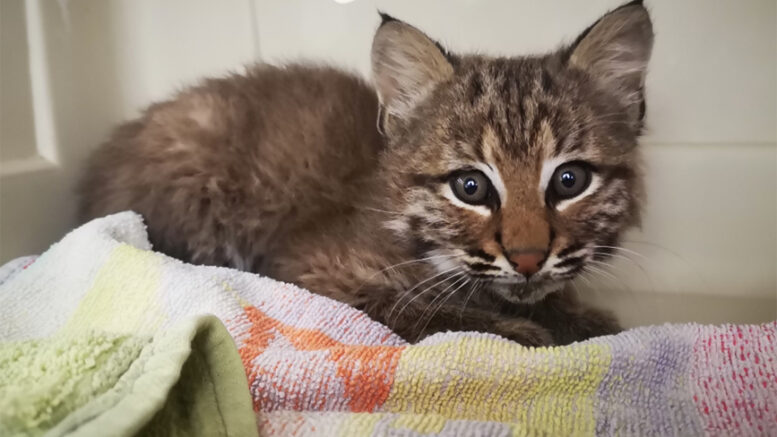Adam Prudhomme
Editor
Marking a first for Napanee’s Sandy Pines Wildlife Centre, the animal rehab centre had an orphan bobcat kitten come into its care last week.
Unfortunately the story had a heart-breaking ending as the kitten made it through one night at the Napanee wildlife rehab centre but passed away shortly after.
Staff at the centre knew it’d be tough sledding from the get-go as orphaned bobcats rarely survive by the time they’re brought into the care of humans.
Noting the interest in the patient on social media, SPWC assistant director Leah Birmingham hosted a Facebook live to provide the details to the public.
“When she came in she was very emaciated, she was very thin. She was very dehydrated,” said Birmingham. “Her skin tent, which is one was we assess it, it just didn’t even respond. When we pinched up her skin it would stay up, it wouldn’t go flat which means there’s no fluid in the body.”
The kitten was found on a front lawn of a home in Odessa-the family that discovered her initially thought it was a standard baby cat. They took her to Millcreek Veterinary Clinic, where staff right away recognized what they were working with and contacted SPWC.
“A couple of things could have happened,” said Birmingham as to why the animal was in the state it was when found. “She may have been travelling with her mom and another kitten and she got nicked by a car. That’s one possibility. She may have had an internal parasite, which is another possibility. Myself and our vet were going over the different potentials that left her so anemic because that was the other thing that was happening, she was very anemic.”
As with any animal brought to the wildlife rehab centre, the staff had to deal with the additional challenge of working on an animal that is stressed by the fact humans are around. Even at a young age, this bobcat displayed signs of knowing humans are generally to be avoided.
“She was trying to sound threatening but it was such a tiny, cute grumble it was not that threatening,” added Birmingham.
After getting some fluids into the animal, there was hope she would start to turn for the better. Tragically, by the next day she was displaying signs of being in a hypoglycemic crisis and organs began shutting down.
“Unfortunately she just kept going downhill so we just let her go,” said Birmingham. “We didn’t want to force her at that point. Once an animal has not had much brain activity for awhile it’s just not fair to bring them back because wild animals can’t be released like that and here at Sandy Pines we are all about releasing wild animals, we don’t like to keep animals in care permanently.”
A post-mortem is scheduled to learn the exact cause of the animal’s distressed state prior to arrive in their care.
Birmingham admitted it was a hard day for all the staff when it became clear the bobcat wasn’t going to pull through.
Though not the ending they wanted, Birmingham said the case did allow them to make contacts within the industry to learn more about bobcat care. While it appears they did everything right in this instance, Birmingham said it was still a first for her 20-year career and a teaching moment for her and the staff. Armed with that knowledge, they are optimistic the next bobcat kitten that arrives in their care will have a better outcome.

